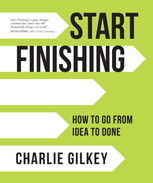
 |
When striving toward achievement with any sort of project or goal, most are all too familiar with getting sidetracked or lost along the way. Whether it be dwindling motivation, a lack of time to focus on the things that matter to you because of family and work obligations, or procrastination, Gilkey provides a detailed plan of getting the gears into motion and finishing the projects you’ve started—more specifically what he calls your “best work.” This concept of best work is a powerful one because it highlights that the projects you want to do are the ones that will fill you with meaning and purpose in life. Your best work isn’t just a task to check off on a list once complete, but a means for you to thrive.
To explain what best work is and the habits you need to break or make for it, Gilkey divides his book into three parts that include a total of ten chapters. The importance of the book’s structure is that it allows the reader to dive into any section of their choosing, depending on what they want to learn. In other words, if a person skips a few chapters or starts in the second or third part, one is still bound to gain knowledge that will help a person better strive towards finishing their best work.
One of the aspects of this book that makes it engaging and helpful is that it’s not just a list of steps to follow. Rather than providing lists to follow robotically, Gilkey shares practical advice that takes into account that the reader is human. He says, “Doing your best work will thus require you to constantly be on the verge of failing,” because if it wasn’t your best work, you wouldn’t be putting your capabilities to the test. It wouldn’t be easy. There will be downfalls, and you will—more often than not—be your worst enemy or obstacle that gets in the way of accomplishing your best work.
In fact, Part One of this book is not just a guide to getting around external barriers but also a motivational discussion that focuses on the internal—how to convince yourself that you are capable of more than you often give yourself credit for. Following the whys of our woes and how to get past the obstacle of ourselves, Part Two is where Gilkey begins to layout methods to getting your best work out into the world. Though he provides an influx of advice, what strings it all together is his detailed look at both goal-making and organization. Without these two factors, reaching the finish line is extremely difficult. He describes how simple things such as adding verbs to your to-do list, splitting a task into smaller chunks to make it less daunting, and more can make an incredible difference. Gilkey even explains how environment, sound, and smell can have an astonishing impact on getting work done. All of these factors sizzle down to organization, whether through schedules (as discussed in Part Three), your surroundings, the people you choose to be your supporters, etc. Essentially, Gilkey accomplishes showing rather than telling as he uses his experience, both as a leader in the Army and through his research and interaction with clients.
Moreover, even the aesthetic of the book’s layout portrays more than its face value. Every page is crisp and neatly designed, largely thanks to the plethora of white space both around and between pages. It makes the book look inviting rather than intimidating, emphasizes the sense of organization that Gilkey says is key to success in any project, and makes it easier to read because of the lack of visual distractions that some other books might have. Gilkey’s conversational writing style also makes it easy to read as it carries his points across without a stutter.
The 2020 Eric Hoffer Book Award Grand Prize Winner
RECOMMENDED by the US Review
Next Focus Review
Previous Focus Review